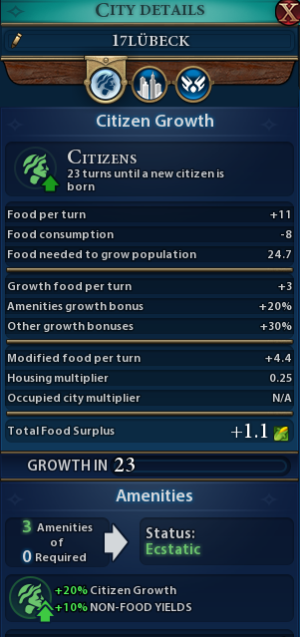It would be ok of he did not hard build the 17th settler.
Some players war and pillage while developing their empire, where you get an constant source of faith and gold.
It only takes new city to grow to pop 2 in 5~8 turns. If one chops wheat/cattle, can rush buy settler on the turn.
Repeat and rinse with satellite cities, wide-expansion empire can be setup rather quickly.
Rush buy districts with Lv4 Renya/Moksha, new cities only priority is to grow to pop 4 asap.
I don't see how this would work out well in most games. If you're settling this many cities, usually one of the following is true:
1. Your cities are so close together they prevent each other from growing
2. Your later cities have bad land
If I'm able to pillage so much gold and faith that I can produce settlers so quickly that I can settle my 17th city early enough to make it a worthwhile investment, why would I be buying settlers? I would just take cities from my opponents.
How many cities will even be able to make good use of Reyna? I usually assign the first four governor titles to Pingala. I need another four to be able to start buying districts with Reyna, and that means I can only start buying districts after I've unlocked either Guilds or Medieval Faires. I'd say I'm doing really well if I get to this point by turn 100. If I want to move Reyna around as quickly as I can, the best I can do is probably two districts. I'd expect that to cost around 1500 gold in the first city that gets this treatment. Let's say this first city was my 11th city overall (so we'll be able to do this in 7 cities). This settler should've cost ~1000g with Monumentality. I had to also buy a builder to chop resources to accelerate the city's growth. Assuming it took 5 turns to settle this city, I spent ~2500g in 10 turns to buy a settler, settle it, let Reyna settle and buy 2 districts in it. I need to do this 7 times. Obviously, I can buy a settler and walk it to its destination while Reyna is settling in my latest city, so let's say there's an overlap of five turns between two cities. That means, to settle and develop seven cities this way, I have to spend ~18k gold (probably much more because of inflation of districts, settlers and builders) over the course of 40 turns (450g per turn). Obviously, we can pillage and use faith as well, but that is a lot of gold and faith to be investing, and keep it mind this doesn't include investments we need to be making for our older cities.
If I divided my empire into two parts, the 10 pre-Reyna cities vs. the 7 post-Reyna cities, how much towards my empire's cumulative yields (starting from the point I produced the 11th settler) would the latter contribute until the end of the game? Usually, I consider 180 turns to be a very good finish for a culture game and 210 for science. Since the OP's looking for a science victory, we're basically looking at maybe around 80 turns on average for the latter group to make their contribution. Considering their much later start and likely inferior land quality, I'd be surprised if these cities could account for more than 20% of the cumulative yields, and that's before we consider the effects of reduced happiness due to having more cities and war weariness from prolonged warfare.
In my opinion, this is much worse than these two alternatives in most games:
1. Settle a few great cities, giving them enough room to grow, and managing amenities well.
2. Invest heavily into military to not only pillage but to take enemy cities. This way, we can get semi-developed cities in good locations that don't encroach severely on our other cities, while weakening rivals. In addition, we can make good use of Warlord's Throne, instead of Ancestral Hall, which I assumed we'd already built in our Reyna scenario, which is why I didn't include the cost of builders required to chop for growth.
There definitely are some exceptions. Germany can build two districts in a new city, while other can only build two, and the production from Hansa can get new cities going very quickly. Plus, Germany doesn't need to worry about growth. Cree can grow new cities quickly with domestic trade routes, although that might mean you want to assign two early governor titles to Magnus.




 - and the AI seems to leave it to me most of the time. I was genuinely surprised in my current game when one of the other Civs built it well ahead of when they usually will.
- and the AI seems to leave it to me most of the time. I was genuinely surprised in my current game when one of the other Civs built it well ahead of when they usually will.